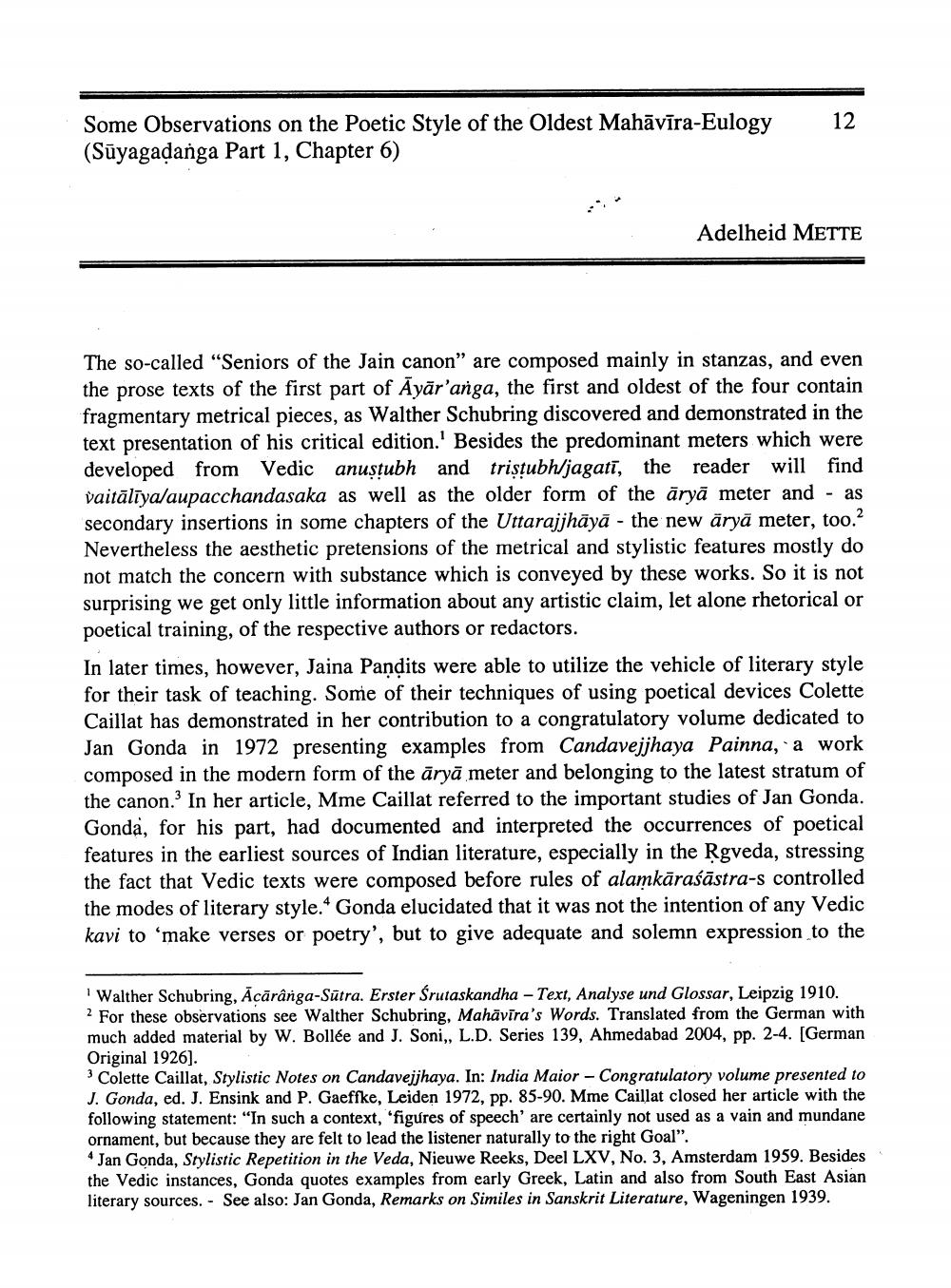________________
12
Some Observations on the Poetic Style of the Oldest Mahāvīra-Eulogy (Sūyagadanga Part 1, Chapter 6)
Adelheid METTE
The so-called "Seniors of the Jain canon" are composed mainly in stanzas, and even the prose texts of the first part of Āyār'anga, the first and oldest of the four contain fragmentary metrical pieces, as Walther Schubring discovered and demonstrated in the text presentation of his critical edition. Besides the predominant meters which were developed from Vedic anustubh and tristubh/jagatī, the reader will find vaitālīya/aupacchandasaka as well as the older form of the āryā meter and - as secondary insertions in some chapters of the Uttarajjhāyā - the new āryā meter, too.? Nevertheless the aesthetic pretensions of the metrical and stylistic features mostly do not match the concern with substance which is conveyed by these works. So it is not surprising we get only little information about any artistic claim, let alone rhetorical or poetical training, of the respective authors or redactors. In later times, however, Jaina Pandits were able to utilize the vehicle of literary style for their task of teaching. Some of their techniques of using poetical devices Colette Caillat has demonstrated in her contribution to a congratulatory volume dedicated to Jan Gonda in 1972 presenting examples from Candavejjhaya Painna, a work composed in the modern form of the āryā meter and belonging to the latest stratum of the canon. In her article, Mme Caillat referred to the important studies of Jan Gonda. Gonda, for his part, had documented and interpreted the occurrences of poetical features in the earliest sources of Indian literature, especially in the Rgveda, stressing the fact that Vedic texts were composed before rules of alamkāraśāstra-s controlled the modes of literary style. Gonda elucidated that it was not the intention of any Vedic kavi to 'make verses or poetry', but to give adequate and solemn expression to the
Walther Schubring, Ācārânga-Sūtra. Erster Śrutaskandha - Text, Analyse und Glossar, Leipzig 1910. 2 For these observations see Walther Schubring, Mahāvīra's Words. Translated from the German with much added material by W. Bollée and J. Soni,, L.D. Series 139, Ahmedabad 2004, pp. 2-4. [German Original 1926). 3 Colette Caillat, Stylistic Notes on Candavejjhaya. In: India Maior - Congratulatory volume presented to J. Gonda, ed. J. Ensink and P. Gaeffke, Leiden 1972, pp. 85-90. Mme Caillat closed her article with the following statement: "In such a context, 'figures of speech' are certainly not used as a vain and mundane ornament, but because they are felt to lead the listener naturally to the right Goal". * Jan Gonda, Stylistic Repetition in the Veda, Nieuwe Reeks, Deel LXV, No. 3, Amsterdam 1959. Besides the Vedic instances, Gonda quotes examples from early Greek, Latin and also from South East Asian literary sources. - See also: Jan Gonda, Remarks on Similes in Sanskrit Literature, Wageningen 1939.




